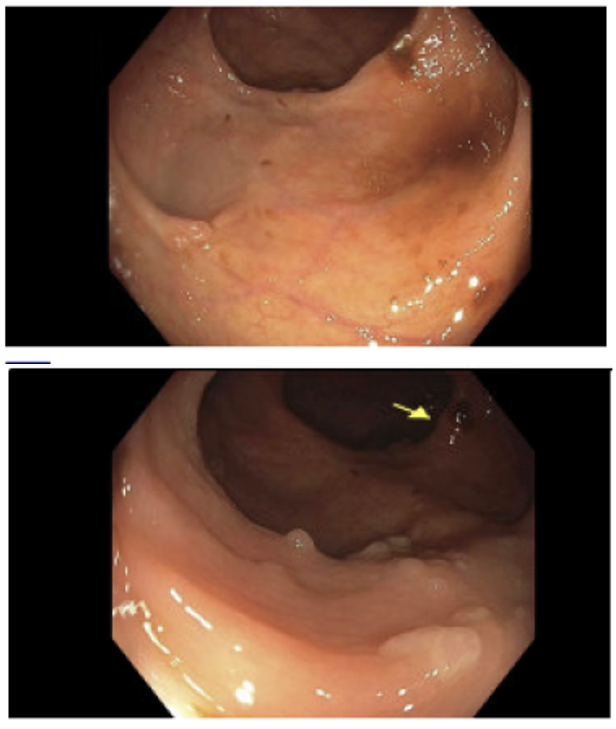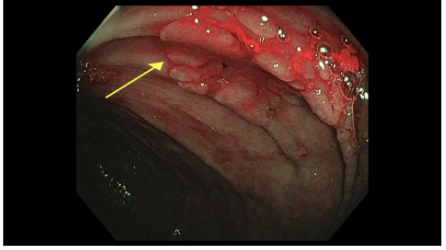Tuesday Poster Session
Category: Interventional Endoscopy
P5720 - Polyp Implantation at Traction Site During Endoscopic Submucosal Dissection for Large Colonic Polyp Resulting in Subsequent Recurrence: A Case for Ongoing Vigilance
Tuesday, October 28, 2025
10:30 AM - 4:00 PM PDT
Location: Exhibit Hall

Rukmoni Balasubramanian, MBBS (she/her/hers)
University of Connecticut
Farmington, CT
Presenting Author(s)
Award: ACG Presidential Poster Award
Rukmoni Balasubramanian, MBBS1, Osama Siddique, MD2, Vaibhav Mehendiratta, MD3
1University of Connecticut, Farmington, CT; 2Connecticut GI, Wallingford, CT; 3Hartford Hospital, Hartford, CT
Introduction: Endoscopic submucosal dissection (ESD) is a technically complex method for removal of large non-pedunculated colorectal polyps and has a significantly lower recurrence rate than endoscopic mucosal resection. We present a case of a patient who underwent successful ESD with opposite wall traction for a large lateral spreading ascending colon polyp, but was later found to have multiple small polyps distal to the resection site, raising concern for satellite lesions at traction site.
Case Description/
Methods: A 53-year-old woman with a family history of colorectal cancer in maternal aunt and grandmother underwent surveillance colonoscopy. A large laterally spreading adenomatous polyp was seen in the ascending colon. The patient was referred for advanced endoscopic resection and the decision was made to proceed with endoscopic submucosal dissection. Repeat colonoscopy revealed a large ( >50 mm) polyp extending from the cecum into the ascending colon, located opposite the ileocecal valve. Careful inspection of ascending colon did not show any other lesions. Endoscopic submucosal dissection (ESD) was successfully performed using clip traction with two hemostatic clips and orthodontic rubber band. Pathology showed a 54mm tubular adenoma with focally extending to lateral margin.
At one-year follow-up colonoscopy, a scar was observed in the proximal ascending colon at site of prior endoscopic submucosal dissection. Distal to this site on opposite wall seven small sub centimeter polyps were seen. These polyps were removed with cold snare and pathology showed tubular adenomas.
Discussion: Endoscopic submucosal dissection (ESD) is an advanced and technically demanding technique that enables en bloc resection of large lesions, with reported local recurrence rates as low as 0.9–2%. Perforations that occur in an area of malignancy during ESD have been reported to cause peritoneal seeding of malignancy. Tumor cell implantation within intestinal lumen has also been reported at distal endoscopic mucosal resection site, proximal location due to specimen retrieval. Metachronous lesions have also been reported due to biopsy or tattoo resulting in contamination of working channel of endoscope. While limited literature exists regarding polyp seeding during endoscopic resection, we believe this is first reported case of satellite lesions forming at site of traction due to contact of polyp with opposite wall during endoscopic submucosal dissection.

Figure: Figure 1 – Colonic polyp seen in ascending colon

Figure: Figure 2.1 – Post ESD scarring noted ; Figure 2.2 – Polyps seen on opposite wall at traction site
Disclosures:
Rukmoni Balasubramanian indicated no relevant financial relationships.
Osama Siddique indicated no relevant financial relationships.
Vaibhav Mehendiratta indicated no relevant financial relationships.
Rukmoni Balasubramanian, MBBS1, Osama Siddique, MD2, Vaibhav Mehendiratta, MD3. P5720 - Polyp Implantation at Traction Site During Endoscopic Submucosal Dissection for Large Colonic Polyp Resulting in Subsequent Recurrence: A Case for Ongoing Vigilance, ACG 2025 Annual Scientific Meeting Abstracts. Phoenix, AZ: American College of Gastroenterology.
Rukmoni Balasubramanian, MBBS1, Osama Siddique, MD2, Vaibhav Mehendiratta, MD3
1University of Connecticut, Farmington, CT; 2Connecticut GI, Wallingford, CT; 3Hartford Hospital, Hartford, CT
Introduction: Endoscopic submucosal dissection (ESD) is a technically complex method for removal of large non-pedunculated colorectal polyps and has a significantly lower recurrence rate than endoscopic mucosal resection. We present a case of a patient who underwent successful ESD with opposite wall traction for a large lateral spreading ascending colon polyp, but was later found to have multiple small polyps distal to the resection site, raising concern for satellite lesions at traction site.
Case Description/
Methods: A 53-year-old woman with a family history of colorectal cancer in maternal aunt and grandmother underwent surveillance colonoscopy. A large laterally spreading adenomatous polyp was seen in the ascending colon. The patient was referred for advanced endoscopic resection and the decision was made to proceed with endoscopic submucosal dissection. Repeat colonoscopy revealed a large ( >50 mm) polyp extending from the cecum into the ascending colon, located opposite the ileocecal valve. Careful inspection of ascending colon did not show any other lesions. Endoscopic submucosal dissection (ESD) was successfully performed using clip traction with two hemostatic clips and orthodontic rubber band. Pathology showed a 54mm tubular adenoma with focally extending to lateral margin.
At one-year follow-up colonoscopy, a scar was observed in the proximal ascending colon at site of prior endoscopic submucosal dissection. Distal to this site on opposite wall seven small sub centimeter polyps were seen. These polyps were removed with cold snare and pathology showed tubular adenomas.
Discussion: Endoscopic submucosal dissection (ESD) is an advanced and technically demanding technique that enables en bloc resection of large lesions, with reported local recurrence rates as low as 0.9–2%. Perforations that occur in an area of malignancy during ESD have been reported to cause peritoneal seeding of malignancy. Tumor cell implantation within intestinal lumen has also been reported at distal endoscopic mucosal resection site, proximal location due to specimen retrieval. Metachronous lesions have also been reported due to biopsy or tattoo resulting in contamination of working channel of endoscope. While limited literature exists regarding polyp seeding during endoscopic resection, we believe this is first reported case of satellite lesions forming at site of traction due to contact of polyp with opposite wall during endoscopic submucosal dissection.

Figure: Figure 1 – Colonic polyp seen in ascending colon

Figure: Figure 2.1 – Post ESD scarring noted ; Figure 2.2 – Polyps seen on opposite wall at traction site
Disclosures:
Rukmoni Balasubramanian indicated no relevant financial relationships.
Osama Siddique indicated no relevant financial relationships.
Vaibhav Mehendiratta indicated no relevant financial relationships.
Rukmoni Balasubramanian, MBBS1, Osama Siddique, MD2, Vaibhav Mehendiratta, MD3. P5720 - Polyp Implantation at Traction Site During Endoscopic Submucosal Dissection for Large Colonic Polyp Resulting in Subsequent Recurrence: A Case for Ongoing Vigilance, ACG 2025 Annual Scientific Meeting Abstracts. Phoenix, AZ: American College of Gastroenterology.

